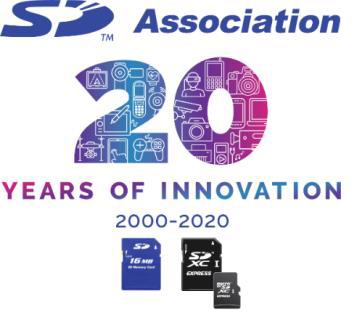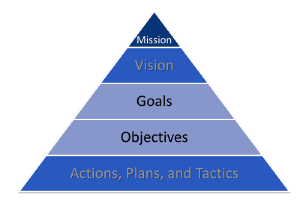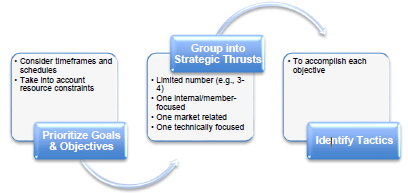

Inventures Insights June 2020
Implementing a Strategic Plan With "SMART" Objectives
We have previously covered the importance of strategic planning and the need for organizations to have a strategic plan, but now what? Having a plan is a great first step, but now that plan must translate into actionable programs and initiatives for your organization.
 |
Virtual Event Realities
The value of face-to-face interaction will never go away, but there are times when going virtual is necessary. While virtual events don't require food and beverage, rather video and connectivity, they share many of the same elements as in-person events.
 |
Client News: SD Express Delivers New Gigabyte Speeds for SD Memory Cards
The SD Association announced the SD 8.0 Specification for future SD Express memory cards offering nearly 4 gigabytes per second (GB/s) maximum data transfer rate creating the fastest cards ever. These full-sized cards use the popular PCI Express® and NVMe Express™ architectures. As always, SD Express memory cards using the SD 8.0 specification maintain backward compatibility.
 |
Why is Thinking so Hard Sometimes?
You've been asked to come to the next meeting with a few new ideas but your creative juices are not flowing and nothing comes to mind. When the meeting starts, the others don't have any ideas, either. There is only silence in the room and everyone is secretly hoping someone will eventually speak up. It's both awkward and frustrating. The good news is, you can avoid this by using a few of the following tips to make group brainstorming easier and less awkward.
 |
 Implementing a Strategic Plan With "SMART" Objectives
Implementing a Strategic Plan With "SMART" Objectives
We have previously covered the importance of strategic planning and the need for organizations to have a strategic plan, but now what? Having a plan is a great first step, but now that plan must translate into actionable programs and initiatives for your organization. And, you must be able to track progress and measure effectiveness of these activities towards achieving the goals of your strategic plan. A strategic plan should create a multi-year operational plan and allocate the required resources accordingly. We want to share with you some of the thinking and steps necessary to realize that multi-year operational plan.
An organization's strategic plan should contain the mission and vision for the organization and also establish strategic goals - those three items form the top of a hierarchy of a multi-year operational plan as illustrated below.

In order to create this plan, the mission must be clearly understood. The vision may evolve as the market and technology changes, but the strategic plan will have captured a snapshot of the vision at the time of the plan. Most importantly, the strategic plan will have defined goals for the organization over a 3-5 year timeframe as the goals clearly document the priorities of the organization. The team then responsible for creating the multi-year operational plan, should use the goals to derive a series of objectives for the organization that are essentially milestones on a plan/roadmap towards achieving those goals. In order to serve that purpose these objectives should all be "SMART" - that is:
- Specific: Means the description of the objective should be easily understood and interpreted the same way be everyone.
- Measurable: Answers the question, "how will you know when it's done?" or if the objective met expectations.
- Achievable: Can the objective be achieved with the proper effort and/or resources.
- Realistic: Even if achievable, is the objective also "realistic" given the resources of the organization (and in the expected timeframe).
- Time bound: The deadline (or expectation) for when the objective should be completed.
Once objectives for the different goals have been identified, one technique that is useful for collaborative organizations like technology alliance is to then group the objectives into strategic thrusts - a limited number (e.g., 3-4 is preferable). One of these thrusts could be internal (member) focused, one could be market related, and one technically focused. The goals and objectives within these thrusts can then be prioritized and ordered based on priority and resource availability. For each objective, tactics and initiatives to accomplish those objectives should be defined. Each tactic should have resources assigned and an "owner" who is responsible for ensuring the tactic is completed. The figure below summarizes this process describe above for translating strategies into objectives and tactics.

In addition to creating and implementing a multi-year operation plan, the organization must be prepared to measure and monitor the progress of the tactics and achievement of the objectives. Based on the progress and results, course corrections could be necessary (including re-allocation of resources). An annual planning process should examine the results and progress of the prior year, when determining objective and tactics for the coming year, so that lessons-learned and changes in external factors can be taken into account.
The above description of the creation of multi-year operational plans is concise due to the limitations on the length of a newsletter article, but the high-level concept, is indeed, not that complex. However, the actual undertaking of this effort should not be underestimated and there are many resources available that describe this kind of process in much more detail and/or consultants available to assist in this process. While that may seem like a daunting task, the value in realizing an actual plan that enables an organization to achieve its strategic goals is invaluable. In our experience, the best performing organizations are the ones that have strategic plans with accompanying multi-year operational plans that they regularly monitor and track.
The value of face-to-face interaction will never go away, but there are times when going virtual is necessary. While virtual events don't require food and beverage, rather video and connectivity, they share many of the same elements as in-person events.
Here are a few reasons to host a virtual event:
- Accessibility: While the event is still being held in-person, virtual options allow you to accommodate attendees who are unable to attend in person.
- Budget: You can deliver the same content to your audience for a fraction of the cost because you don't have to worry about meeting room costs, meals, entertainment, etc.
- There's no other option: Whether due to the extreme weather, travel bans, or an act of God, you're forced to make your in-person event virtual vs. cancelling it altogether.
Anyone can run virtual events effectively by using best practices and easy-to-use, easily available technology. However, executing a successful virtual or hybrid event is much more than turning on a camera or downloading a live streaming mobile app. By following these tips, you can deliver an effective virtual meeting experience:
1. Use video. To make people feel like they're all at the same event, use video conferencing rather than traditional conference dial-ins. Technology — such as Zoom, Skype, and GoToMeeting — helps to personalize the conversation and keep participants engaged.
2. Always provide an audio dial-in option. Video conferencing can work very well, but it relies on a strong internet connection that may not always be available. People need the option to participate via audio, if needed.
3. Test the technology ahead of time. Prior to a virtual event, all presenters should test the technology and make sure they are comfortable with all the features.
4. Make sure faces are visible. Video conferences are more effective when people can see each other's facial expressions and body language.
5. Stick to meeting basics. Prior to the event, set clear objectives and send any information to your attendees if needed. During the session, use an agenda that clearly outlines the format and timing.
6. Minimize presentation length. The only thing worse than a long presentation in person is a long presentation during a virtual event. If someone needs to present, use screen sharing to guide the conversation, so attendees can truly be on the same page.
7. Use an icebreaker. Icebreakers are discussion questions or activities used to help participants relax and ease people into a group meeting or learning situation. It is important to build in time for an icebreaker because it can create a positive group atmosphere, break down social barriers, motivate and help people think about the topic.
8. Capture real-time feedback. Distractions are everywhere. If you want your event to be a success, you must find ways to make it engaging. Live polls, live chat, and live Q&A all help increase audience's participation.
Converting your in-person event to a virtual event may seem daunting. But by following these tips, you can get an amazing virtual event running smoothly, that still provides value to your attendees.
 Client News: SD Express Delivers New Gigabyte Speeds for SD Memory Cards
Client News: SD Express Delivers New Gigabyte Speeds for SD Memory Cards
The SD Association announced the SD 8.0 Specification for future SD Express memory cards offering nearly 4 gigabytes per second (GB/s) maximum data transfer rate creating the fastest cards ever. These full-sized cards use the popular PCI Express® and NVMe Express™ architectures. As always, SD Express memory cards using the SD 8.0 specification maintain backward compatibility.
SD Express gigabyte speeds bring new storage opportunities for devices with demanding performance levels, across a variety of industries. The cards can move large amounts of data generated by data-intense wireless or wired communication, super slow motion video, RAW continuous burst mode and 8K video capture and playback, 360 degree cameras/videos, speed hungry applications running on cards and mobile computing devices, ever evolving gaming systems, multi-channel IoT devices and automotive to name a few. SD Express will be offered on SDHC, SDXC and SDUC memory cards.
 Why is Thinking so Hard Sometimes?
Why is Thinking so Hard Sometimes?
You've been asked to come to the next meeting with a few new ideas but your creative juices are not flowing and nothing comes to mind. When the meeting starts, the others don't have any ideas, either. There is only silence in the room and everyone is secretly hoping someone will eventually speak up. It's both awkward and frustrating. The good news is, you can avoid this by using a few of the following tips to make group brainstorming easier and less awkward.
- Set directions - Clearly describe and define the situation BEFORE the meeting
- Involve everyone - Encourage everyone to contribute and CONTROL dominating participants
- Cross-fertilize - BUILD on each other's ideas
- Get out of the box - Use different techniques to generate BIGGER and WILDER IDEAS. Think creatively and not tactically
- Don't overlook the obvious - Sometimes the OBVIOUS IDEA is the best
- Suspend judgment - No ideas are bad ideas and ALL IDEAS are good ideas. A minority opinion offered during group decision making often stimulates more innovative solutions to a problem
- Don't fear repetitions - The same idea at different times can SPUR different reactions
- Do not stop and discuss - Go for QUANTITY, NOT QUALITY
- Document - Record and DISPLAY each idea
- Have a good time - Make it FUN!
Generating new ideas should not be a chore. Simply carve out time to think creatively and give ourselves permission to think outside the box. So put that thinking cap on, don't be shy, and remember, there is never a bad idea in a brainstorm!

Copyright © Global Inventures, Inc.